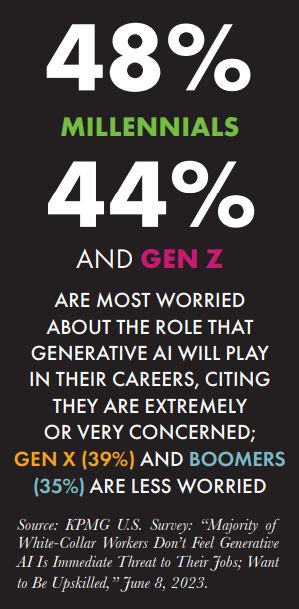By Mike DiClaudio and Kristine Coogan
Today’s workforce is becoming increasingly diverse, with five generations working side-by-side: Generation Z, millennials, Generation X, baby boomers, and traditionalists.
This phenomenon presents both opportunities and considerations for employers, and has the potential to play out in a variety of ways. For example, a recent KPMG study, revealed that some Gen Z employees care more about online courses to learn new skills (41%) and mental well being (35%) than perks like free lunches compared to other generations. These findings also reflect that generations are not monolithic. Stereotyping workers by generation can have negative impacts on a company’s retention of talent, culture, reputation and success. It is critical for business leaders to understand and appreciate the differences and similarities within and between generations. It’s a win-win for the company and employees, creating an environment that develops a productive and talented workforce and builds the company’s reputation and business.
Hear are Four Factors that can Impact the Success of a Multi-Generation Workforce
Diverse Learning and Knowledge Transfer: May be Situational as Well as Generational
The pandemic has demonstrated the value of both digital and face-to-face development within and across generations as we now have in-office, hybrid, and remote working. Employers need to provide a variety of learning opportunities that cater to different working arrangements and learning preferences, understanding that preferences may be situational as well as generational.
With the retirement of traditionalists and baby boomers, there is a risk of losing valuable knowledge and experience. Employers must ensure that knowledge transfer occurs to prevent this loss and consider preferred learning styles in doing so. This can be achieved through mentoring programs, job shadowing, and cross-generational training. Employers also need to ensure that knowledge is accessible to all generations. Reverse mentoring programs are another way to share knowledge to help more senior employees develop skills.
Continuous Learning: On-Demand and Microlearning Better Alternatives
Best practices include enabling better ways of working through casual interactions and informal learning, versus formal courses and training programs. Opportunities to explore career development goals and new perspectives on ways of working in a less structured setting contributes to an innovative culture. On-demand learning and microlearning are often preferable versus more formal programs. These are approaches and opportunities that may be valued by employees across all generations.
 Technology: Must be Accessible for All Generations
Technology: Must be Accessible for All Generations
With emerging technologies like generative AI, employers are working to ensure that their technology infrastructure is accessible for all generations. This may require additional training and support. The KPMG study referenced earlier found that millennials (48%) and Gen Z (44%) are most worried about the role that generative AI will play in their careers, citing that they are extremely or very concerned.
However, it’s clear gen AI will be a valuable productivity tool and a critical part of digital literacy for the workforce. In a separate KPMG study, 62% of respondents felt that gen AI could end up encouraging innovation.
Communication: Must be Tailored to Audience and Offered in Many Formats
Communication is the bedrock of successful collaboration among generations and should to be tailored to the audience and offered in many formats in order to be effective. As employees think about the increasingly multigenerational workforce, listening, learning, and approaching every facet of work life with an open mind will enable effective communications and empower employers to make informed decisions.
Conclusion: Five-Generation Workforce Offers Great Opportunity
A five-generation workforce presents many opportunities for employers. By understanding and embracing both the unique and similar characteristics, values, and expectations of each generation, employers can create an inclusive and supportive workplace. It’s a workplace that retains and attracts talent, and the companies that win the fight for talent will be well positioned for success.
Mike DiClaudio is KPMG Principal, Advisory Head of Talent Strategy and Kristine Coogan is KPMG Principal, People Strategy.

